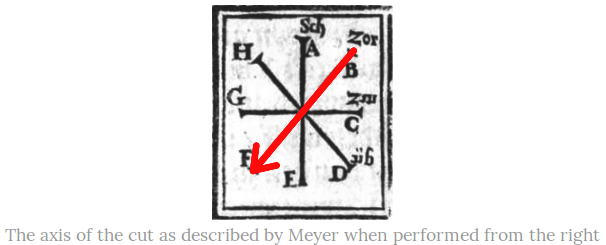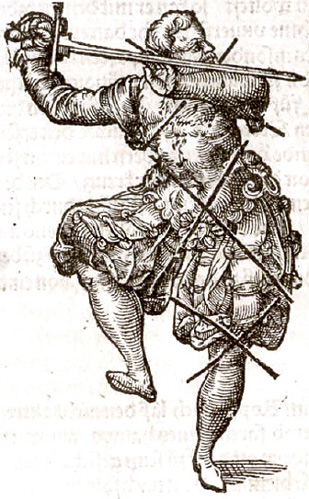Zornhauw
Wrath Strike
Longsword
A powerful diagonal strike from above.
Summary
- Diagonally downward cut, attacking the upper openings.
- Guard transitions: Zornhut – Wechsel
- Advantages: Powerful, the 45 degree angle gives it good structure both horizontally and vertically, so it is difficult to set aside and also effective in cutting into the opponent’s strike as a parry & strike at once.
- Disadvantages: This is the most common strike seen in most exchanges, as such opponents are usually ready for it.
Execution
The canonical zornhauw is carried out as follows:
Full Cut
- Begin in the guard zornhut with the left foot forward.
- Cast the blade out and downward so it comes around with a downward motion at around 45 degrees.
- As the blade’s tip passes the shoulder begin the passing step forward with the right foot, landing it at the blade passes through an angled, langort position.
- The blade continues its motion down and to the guard of wechsel on the left hand side.
To continue the movement come back to zornhut by slashing up and weighting yourself backward, and continue again.
Abbreviated Cut
- Begin in the guard langort with the left foot forward.
- Lift the pommel and drop the tip through hangetort
- Cut around to the other side and as the blade passes forward step forward after it with a passing step on the right foot, to land in langort once again.
To continue the movement simply move through hanging point again and continue cutting.
Considerations
The zornhau is the most powerful of the strikes in Meyer’s system, and also one of the most versatile. It is simultaneously a defence and attack, and can be carried all the way through and around for follow on strikes, or may be halted “on point” with the opponent to threaten with the point. We will begin with the cut all the way from the guard zornhut to wechsel.
The motion of the blade should maintain the same diagonal line throughout the strike, and the cutting line should be straight and not scallop downward to the vertical or across to the horizontal.
On of the main benefits of the zornhau is that its cutting direction give it both a horizontal and vertical component to its momentum. This means that it can be used as a cutting parry to both vertical and horizontal strikes, relying on its greater horizontal component to parry vertical cuts (which have no horizontal momentum with which to oppose it), and likewise uses the vertical component to offset horizontal cuts (because they have no vertical momentum of their own). By the same reasoning it is more difficult to directly parry a zornhau with these single axis strikes.
Notes
The cut is often carried out best with a casting-out motion using a push-pull of the hands rather than bringing the arms in a purely chopping action. This gives superior reach and speed and allows the blade to rotate out to longpoint over the opponent's blade, using the momentum of the blade around a point of rotation about the hilt to give superior leverage over their blade.
While the cut can carry all the way through we very often want to end on-point, threatening the face in Langort and holding the opponent at a distance, forcing them to react to our point, thus taking the Vor from them. This is a classic way of taking the initiative.
Applications
The Basic Zornhauw
In this application the cut is being used as a Hitter. In this case the fencer is acting in the Vor as a form of Nachreisen.
| Teacher | Student |
|---|---|
| Pflug, left leg forward | Zornhut or Vom tag, left leg forward, out of distance |
| Gathering Step back and forth, eventually dropping the sword low or bringing it to the shoulder. | Chase Nachreisen the opening with a Passing Step forward with the right foot, cut a Zornhauw |
| Withdraw (Abzug) with a defensive high cut or a guard. |
Perform this also from the opposite side.
Application 1 - Zornhauw Parry with Schießen
In this application the cut is being used as a Taker. In this case the fencer is acting in the Nach.
| Teacher | Student |
|---|---|
| Vom tag, left leg forward | Zornhut or Vom tag, left leg forward |
| Cut an Oberhauw with a passing step. | Cut a Zornhauw as a parrying and threaten forward (drawing a strong pressure), perform a Passing Step slightly right, with the right foot. |
| Defender is weak at the blade, ceding the centre line. | Threaten the opponent's face with the point by turning and extending forward into a thrust, shooting the point forward Schießen. |
| Withdraw (Abzug) with in Longpoint. |
Perform this also from the opposite side.
Application 2 - Zornhauw Parry with Abnehmen/Umbschlagen
In this application the cut is being used as a Taker. In this case the fencer is acting in the Nach.
| Teacher | Student |
|---|---|
| Vom tag, left leg forward | Zornhut or Vom tag, left leg forward |
| Cut an Oberhauw with a passing step. | Cut a Zornhauw as a parrying and threaten forward (drawing a strong pressure), perform a Passing Step slightly right, with the right foot. |
| Defender is weak at the blade, ceding the centre line. | Threaten the opponent's face with the point by turning and extending forward into a thrust, shooting the point forward Schießen. |
| The defender parries strongly offline, but does not threaten the point. | Take off above (see also Abnehmen) and cut around with a flick over the blade to the other side (Umbschlagen) to the hands or head. |
Perform this also from the opposite side.
Application 3 - Zornhauw Versetzen (Parrying) with Ablauffen (flowing off)
In this application the cut is being used as a Provoker followed by a Hitter. In this case the fencer is acting in the Vor.
It is suitable against those who parry online as the lifting hands and flowing off (Ablauffen) sets their point aside.
| Teacher | Student |
|---|---|
| Vom tag, left leg forward | Zornhut or Vom tag, left leg forward |
| Cut a Zornhauw as a parrying and threaten forward (drawing a strong pressure) | |
| Parry the cut and push forward against it. | Lift the hands high and let the Teacher's blade flow off to your right, looping around to cut a Zornhauw to the upper right opening. Step forward and left with the left foot to accompany the cut. |
| Withdraw (Abzug) with a defensive high cut or a guard. |
Perform this also from the other side.
Application 4 - Zornhauw Verfuhren (deceiving) with Fehlen (Failing)
In this application the cut is being used as a Provoker followed by a Hitter. In this case the fencer is acting in the Vor.
Notice that this technique starts a false step, then aborts it and uses a gathering step to finish the technique, it is only suitable against those who parry with their point offline.
| Teacher | Student |
|---|---|
| Vom tag, left leg forward | Zornhut or Vom tag, left leg forward |
| Cut a Zornhauw at his upper left opening, perform a Passing Step with the right, but terminate it as your feet pass through the transition point so the feet are close together. | |
| Parry the blow aside with a Zornhauw | As soon as you see his hands move, lift the hands high and, looping around, cut a Zornhauw to the upper right opening without making contact with his blade. Step forward and left with the left foot. |
| Withdraw (Abzug) with a defensive high cut or a guard. |
Perform this also from the other side.
Application 5 - Zornhauw Verfuhren (deceiving) with Wechseln (Changing)
In this application the cut is being used as a Provoker followed by a Hitter. In this case the fencer is acting in the Vor.
Notice that this technique starts a false step, then aborts it and uses a gathering step to finish the technique. It is only suitable against those who parry to the sword with the point offline.
Notice that we would normally use a thrust from the changing through, but are being very specific to the text here.
| Teacher | Student |
|---|---|
| Vom tag, left leg forward | Zornhut or Vom tag, left leg forward |
| Cut a Zornhauw at his upper left opening, perform a Passing Step with the right, but terminate it as your feet pass through the transition point so the feet are close together. | |
| Attempt to parry the blow aside with a Zornhauw offline. | As soon as you see his hands move, pull the blow back and drop the point beneath his and cut to his hands or body on the other side, turning your long edge toward his sword. Step forward and left with the left foot. |
Application 6 - Zornhauw with Doplieren (Doubling)
In this application the cut is being used as a Provoker followed by a Hitter by using Doplieren. In this case the fencer is acting in the Vor.
| Meister | Lehrling |
|---|---|
| Vom tag, left leg forward | Vom tag, left leg forward |
| Cut a Zornhauw | |
| Push the pommel through under the right arm, cut a Sturtzhauw like cut to the head behind his blade, or a zwerch like blow to the face, with stepping a step out to your right with the right leg. |
Related Applications
The following applications are related to, or derive from, this strike.
- Zornhauw-Ort - see Meisterhauw
Dussack
The dussack uses the same manner of zornhauw as the longsword and rappier; a cut through the diagonal line. As with the other weapons this can continue through to longpoint then change off to another guard, or can be followed all the way down to Wechsel.
Rappier
The rappier also uses the Zornhauw cut. With the rappier the cut follows the same line as the longsword cut of the same name, cutting down from Oberhut, down through Langort and following all the way down to Wechsel if the fencer so desires.
When the diagonal cut is used directly as an attack it is described as a Zornhauw, whereas when it is used to parry aside a blow it is called the defense stroke (Wehrstreich), when aimed at shoulder height it is described as the shoulder cut (Achselhauw), at waist height the hip cut (Huffthauw), and at knee height the Schenckelhauw - Thigh Cut. These cuts can be performed from either side.
The diagram below shows the various cuts to the targets.
With each of these cuts Meyer advocates that we widen and lower our stance commensurate with the cut we're performing. The high diagonal, for example, is performed quite upright, the middle cross extends the stance by about a foot's width, bending the front knee well forward. The lowest cross goes even further apart with more bend to the front leg so the whole body lowers to the extent required by the cut. Meyer tells us that this last type of cut is not for everyone owing to the athleticism it requires.
We are also told we can cut to the three levels in rapid succession along alternating diagonals in an S pattern from top to bottom and back again.

